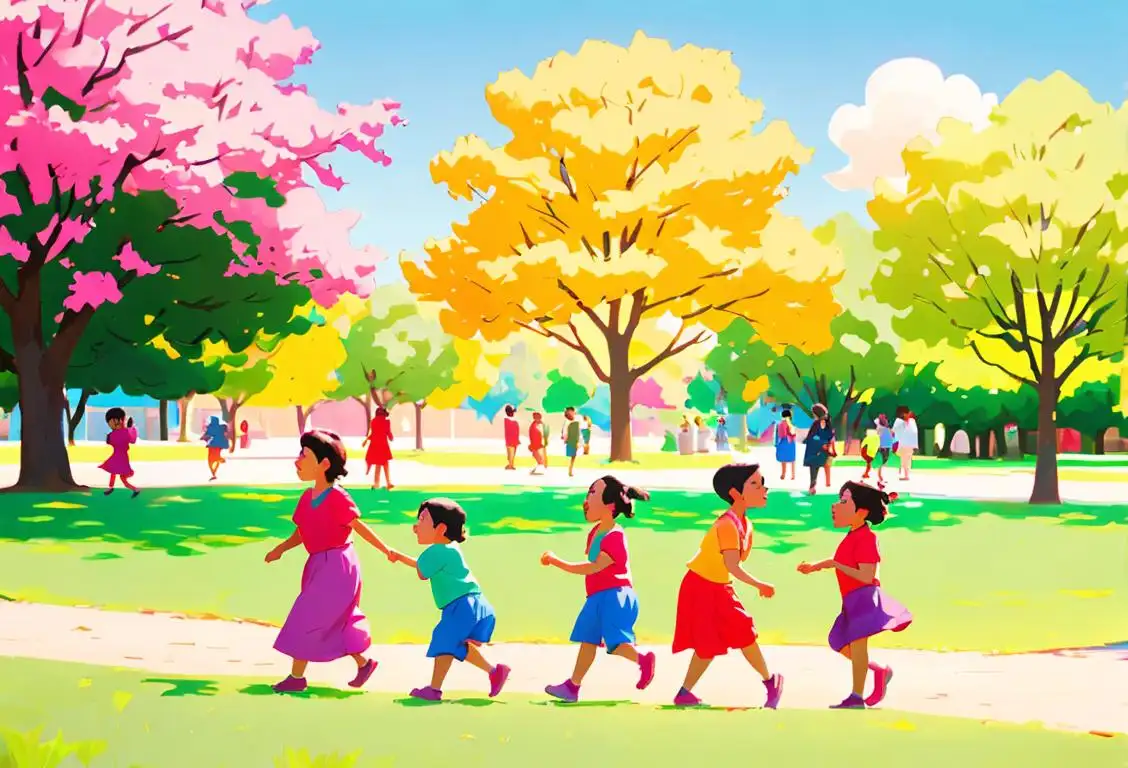National Indie Bookstore Day

Welcome to the whimsical world of National Indie Bookstore Day! Get ready to dive into cozy nooks and embark on literary adventures. It's a day of celebrating these charming havens that house the treasures of the written word. So, grab a cup of tea, curl up under a fuzzy blanket, and join us as we explore the internet history of this delightful national day!
When is Indie Bookstore Day?
It's national indie bookstore day on the 27th April.
Indie Bookstores: A Haven for Bookworms
Picture this: a cozy shop with shelves stacked high, where every nook and cranny is filled with books of all genres. The delightful smell of aged paper gently tickles your nostrils as you embark on a grand adventure through the written word. This, my friend, is the enchanting world of indie bookstores. These beloved establishments are not simply places to purchase books; they are sanctuaries for book lovers to escape the hustle and bustle of everyday life.
Did you know that National Indie Bookstore Day was first celebrated on April 27, 2019? It quickly gained popularity and has since become an annual celebration of the unique and magical experiences that indie bookstores offer.
A Community of Bookworms
Indie bookstores are not just brick-and-mortar shops; they are community hubs where bookworms gather to share their love for literature. These bookstores often host author events, book clubs, and writing workshops, fostering a sense of connection among book lovers. They provide a haven for meaningful conversations and a sanctuary for those seeking solace in the pages of a book.
One of the most beautiful things about indie bookstores is their ability to curate a personalized collection of books. Unlike large chain bookstores, indie bookstores handpick each title, creating a unique and carefully curated selection. This means you're more likely to stumble upon hidden literary gems, rediscover forgotten classics, and support local authors.
A Digital Age Haven
In this digital age, where e-books and online retailers dominate the market, indie bookstores stand as a testament to the enduring power of physical books. They offer an escape from pixelated screens and the chance to disconnect from the virtual world. The tactile experience of flipping through pages, the weight of a book in your hands, and the sound of a spine cracking open are irreplaceable pleasures that indie bookstores celebrate.
So, next time you find yourself craving literary bliss, step inside an indie bookstore. Immerse yourself in the enchanting atmosphere, run your fingers along book spines, and lose yourself in the magic of stories waiting to be discovered. Let National Indie Bookstore Day be a reminder to support these havens of literature, keeping the spirit of reading alive for generations to come.
History behind the term 'Indie Bookstore'
1960s
Birth of the Independent Bookstore
During the 1960s, a cultural shift was happening. Independent bookstores began to emerge as alternatives to the larger chain stores. These independent bookstores catered to niche audiences and embraced a more personal and curated approach to book selling. They provided a haven for avid readers looking for a unique experience.
1936
The Birth of Independent Bookstores
In 1936, the first independent bookstore, Shakespeare and Company, was established in Paris by American expatriate Sylvia Beach. This bookstore became a haven for aspiring writers and intellectuals, including renowned figures like Ernest Hemingway and F. Scott Fitzgerald. The unique charm and curated selection of independent bookstores began to capture the imagination of book lovers around the world.
1970s
The rise of independent bookstores.
During the 1970s, a movement emerged in the United States that highlighted the need for independent bookstores. These stores, often referred to as 'indie bookstores,' aimed to provide personalized service and a unique selection of books that were not easily found in mainstream retail chains like Barnes & Noble or Borders. Indie bookstores became known for their curated collections, knowledgeable staff, and cozy atmosphere.
1970
Birth of the indie bookstore movement
In the 1970s, amidst the rise of corporate bookstore chains, a countercultural movement began to emerge with the aim of supporting independent, locally-owned bookstores. These bookstores, often run by passionate individuals, became the heart and soul of their communities, offering a curated selection of books and a personalized, welcoming environment.
1940s
The rise of independent bookstores
In the 1940s, independent bookstores began to flourish, offering a wide selection of books that catered to niche interests and literary preferences. These stores were characterized by their unique atmosphere, personalized recommendations, and a commitment to supporting local authors and publishers.
1960s
The Rise of Independent Bookstores
During the 1960s, independent bookstores began to emerge as a counter-culture response to the growing commercialization of the publishing industry. These bookshops focused on offering alternative literature, often challenging mainstream ideas and promoting diverse voices. This movement gave birth to what we now know as 'indie bookstores.' These spaces became vibrant meeting places for writers, intellectuals, and avid readers.
1971
The Birth of Independent Bookstores
In 1971, large chain bookstores dominated the market, offering a limited selection of books. However, this year marked a significant development in the world of book retailing as the first indie bookstore, Book Soup, opened its doors on Sunset Strip in West Hollywood. It quickly became a hub for book lovers seeking a diverse range of titles from both established and emerging authors.
1970s
Indie Bookstores Gain Momentum
During the 1970s, independent bookstores gained momentum as counterculture and alternative movements emerged. These bookstores often acted as cultural hubs, hosting readings, discussions, and events that brought together communities of diverse interests. The personalized service, knowledgeable staff, and commitment to stocking a wide range of titles helped indie bookstores carve out a distinct niche in the literary landscape.
1980
Rise of the term 'indie'
During the 1980s, the term 'indie' (short for 'independent') gained popularity in various creative fields, including music and film. Inspired by this cultural trend, the term 'indie bookstore' started to be used to describe these unique, non-chain bookshops that operated outside of the mainstream. The term encapsulated the spirit of independence, creativity, and rebellion against the homogeneity of mass-market bookstores.
2000
The surge of online competition.
In the early 2000s, online retailers like Amazon gained popularity and presented a significant challenge to indie bookstores. The convenience and wide range of choices offered by online shopping led to a decline in sales for brick-and-mortar bookstores, including indies. Many indie bookstores struggled to compete with the low prices and fast shipping options of online giants.
1978
The Coined Term
The term 'indie' itself gained popularity in the late 1970s, primarily within the music industry to describe independent record labels and musicians who produced and distributed their music outside of major corporate labels. The term gradually spilled over to other artistic domains, including independent bookstores. It was a perfect fit since indie bookstores shared similar values of championing independent voices and ideas.
1970s
Rise of the DIY Ethos
In the 1970s, the Do-It-Yourself (DIY) ethos gained popularity. This movement encouraged individuals to create and sell their own products. Many artists and authors embraced this spirit and started self-publishing their books. Independent bookstores became crucial platforms for showcasing these self-published works, elevating the status of these stores within their communities.
1982
Banding Together for Survival
Through the 1980s, independent bookshops faced stiff competition from chain stores and declining book sales. In response, independent booksellers recognized the need to band together to strengthen their influence and survive in a changing market. This led to the creation of organizations like the American Booksellers Association (ABA), facilitating collaboration and knowledge sharing among indie bookstores.
1960s
Counterculture influences
During the counterculture movement of the 1960s, independent bookstores became gathering places for intellectuals, artists, and activists. These stores provided a space for alternative literature and ideas that were often not found in mainstream bookshops. Their emphasis on freedom of speech and the exchange of progressive ideas set them apart as cultural hubs.
1990
Indie bookstores vs. big chains
In the 1990s, indie bookstores faced fierce competition from large corporate chains like Barnes & Noble and Borders. Despite being up against powerful entities, indie bookstores continued to thrive with their personalized service, diverse book selections, and a strong connection to local authors and readers. They became cultural hubs, hosting literary events, book clubs, and fostering a sense of community.
1980s
Cultural Impact of the Term 'Indie'
In the 1980s, the term 'indie,' short for 'independent,' became a popular descriptor for various subcultures and creative endeavors. The term originated in music to refer to independent record labels and artists. It later extended to independent films and then to independent bookstores. Being labeled as an 'indie' store signaled that the establishment operated outside of mainstream conventions and was committed to supporting alternative voices and perspectives.
1980s
The Rise of Chain Bookstores
In the 1980s, chain bookstores like Barnes & Noble and Borders began to expand rapidly, posing a significant threat to independent bookstores. These mega-stores offered lower prices and a wider selection, influencing reader habits and challenging the survival of indie bookstores. However, despite the competition, many independent bookstores managed to carve out their niche with their curated selections, personalized customer service, and their role as community hubs.
1970s
The birth of the 'indie' term
In the 1970s, the term 'indie' emerged as an abbreviation for 'independent,' and it quickly found its way into the lexicon of the book industry. Small, independent bookstores embraced the term as a way to differentiate themselves from larger chain stores. 'Indie' became synonymous with a more intimate, community-driven bookstore experience.
2000
The Rise of Online Retail
With the advent of the internet, the book industry witnessed a seismic shift in the way books were bought and sold. Online retailers like Amazon offered convenience and extensive selections at competitive prices, posing a new challenge to indie bookstores. To adapt, many indie booksellers embraced e-commerce, establishing online platforms to reach a broader audience and compete in the digital age.
2009
The 'Shop Local' movement.
In 2009, a 'Shop Local' movement began to gain traction, encouraging consumers to support local businesses. As part of this movement, there was a renewed interest in indie bookstores. People recognized the value of these unique establishments in preserving local culture, fostering community engagement, and providing a different shopping experience than online retailers. This resurgence helped revive many struggling indie bookstores.
2000s
The Rise of Online Retail
With the advent of online retail giants like Amazon, independent bookstores faced significant challenges. Many small brick-and-mortar bookshops struggled to compete with the convenience, lower prices, and vast selection offered by online platforms. Some even closed their doors forever. However, a growing movement of book lovers recognized the cultural importance of these indie bookstores and rallied to support them.
1990s
Indie bookstores in the digital age
With the advent of online shopping and e-books in the 1990s, indie bookstores faced new challenges. However, many managed to adapt and thrive by emphasizing their unique offerings. Indie bookstores focused on curated selections, author events, and creating physical spaces that fostered a sense of community. They became havens for book lovers seeking a more personal and tactile experience.
2009
Celebrating Independent Bookstores
In 2009, Independent Bookstore Day was launched. This annual event celebrates the unique role and cultural impact of indie bookstores, inspiring book lovers to support their local independent establishments. Independent Bookstore Day highlights the importance of these bookshops as community gathering places, fostering literary conversations and nurturing a love for literature and independent voices.
1990s
Indie Bookstores as Cultural Anchors
By the 1990s, indie bookstores had established themselves not only as places to discover unique books but also as important cultural anchors within their communities. They hosted author readings, book clubs, literary events, and became a platform for local artists and activists. Indie bookstores fostered a sense of community and intellectual exchange, offering an intimate and welcoming space for book lovers to connect with each other and the written word.
2008
Independent Bookstore Day
In 2008, the first Independent Bookstore Day was celebrated in the United States. This annual event, held on the last Saturday of April, aims to highlight the significance of independent bookstores and their contribution to local communities. Independent Bookstore Day offers special promotions, author events, and exclusive merchandise to encourage people to visit and support their local indie bookshops.
2014
Indie Bookstore Day is born.
To celebrate the resurgence of indie bookstores, the first Indie Bookstore Day was held in 2014. The annual event takes place on the last Saturday of April and aims to support and promote indie bookstores across the United States. It features exclusive items, author appearances, special events, and encourages readers to explore their local indie bookshops.
1990s
Indie Bookstores vs. Chain Stores
During the 1990s, chain bookstores started to dominate the market. Independent bookstores faced increasing competition from these larger establishments. However, the unique charm, personalized recommendations, and community-centric focus of indie bookstores helped them maintain a loyal customer base. Many people preferred the cozy and intimate atmosphere of indie bookstores over the impersonal nature of chain stores.
2005
Indie bookstore resurgence
By the mid-2000s, indie bookstores experienced a resurgence in popularity, partly due to a growing interest in supporting local businesses and a desire for authentic, unique experiences. Additionally, the rise of online retailing led to a backlash against the impersonal nature of online shopping, leading readers to seek out physical indie bookstores where they could discover hidden gems and engage in meaningful conversations with knowledgeable staff.
2019
Indie bookstores in the digital age
In the modern era, indie bookstores have embraced technology to compete and adapt to changing consumer habits. Many indie bookstores now offer e-books, audiobooks, and have integrated online platforms to sell books to customers worldwide. However, they continue to provide an offline experience that cannot be replicated online, creating unique spaces that celebrate the joy of physical books and the culture surrounding them.
Present
Indie bookstores today
Today, indie bookstores continue to be cherished institutions in communities around the world. They play a vital role in promoting diverse literature, supporting local authors, and maintaining the joy of browsing physical books. Indie bookstores have become cultural landmarks, providing a space where people can gather, discover new stories, and connect with like-minded individuals.
Present Day
Survival and Revival
In the face of major challenges such as online retail giants and e-books, indie bookstores have continued to adapt and find innovative ways to survive and thrive. Many have embraced their unique qualities, focusing on providing personalized recommendations, curating niche collections, and strengthening community ties. Moreover, the resurgence of support for local businesses and a desire for more diverse literary offerings has led to a revival of interest in indie bookstores. Today, these beloved cultural institutions continue to play a vital role in fostering a love for literature and maintaining vibrant communities.
Present Day
Resurgence of Indie Bookstores
Despite the challenges posed by online retailers, indie bookstores have experienced a resurgence in recent years. Many book lovers appreciate the unique experience that these stores offer: the ability to browse physical books, interact with knowledgeable staff, attend literary events, and engage with a community of readers. The intimate, cozy atmosphere and carefully curated selection of indie bookstores continue to captivate both avid readers and those in search of a literary adventure.
Present
Continued growth and adaptation.
Today, indie bookstores continue to thrive and adapt in the digital age. Many indie bookshops have embraced online selling, social media engagement, and community events to complement their physical stores. They play a vital role in fostering a love of literature, promoting diverse voices, and creating spaces for intellectual discussions and cultural events. Indie bookstores have become cherished destinations for book lovers, attracting both locals and tourists alike.
2010s
Resurgence and Renewed Appreciation
In the 2010s, indie bookstores experienced a resurgence, driven by a growing appreciation for their personalized service, curated selections, and vibrant communities. As readers sought personalized recommendations and a more immersive book-buying experience, indie bookshops perfectly fit the bill. This renewed enthusiasm empowered indie bookstores, allowing them to thrive and adapt to changing consumer preferences.
2000s
'Shop Local' Movement
In the 2000s, a resurgence of support for local businesses, also known as the 'shop local' movement, gained momentum. People began recognizing the importance of independent bookstores as cultural hubs within their neighborhoods. Indie bookstores became more than just places to buy books; they became gathering spaces for author events, book clubs, and community discussions, fostering a sense of camaraderie that online retailers and chain stores often lacked.
Present
Continued Resilience and Adaptation
Today, indie bookstores continue to thrive despite the rise of e-books and online retailers. They have adapted by curating unique selections, hosting events, offering personalized recommendations, and providing memorable customer experiences. Many indie bookstores have also joined forces to create regional and national networks, ensuring their collective strength. These bookstores have become bastions of literary culture, preserving the diverse voices and stories that make them an essential part of our communities.
Did you know?
Did you know that the oldest independent bookstore in the United States is the Moravian Book Shop in Bethlehem, Pennsylvania? It first opened its doors in 1745 and continues to be cherished by book enthusiasts to this day!Tagged
romance nsfw funFirst identified
28th April 2015Most mentioned on
27th April 2019Total mentions
134Other days
Aldub Day
Weatherpersons Day
Love Pizza Day
Kisses Day
Awareness Day
One Day
Children Day
Happiness Day
Opposite Day
Ojd Day









